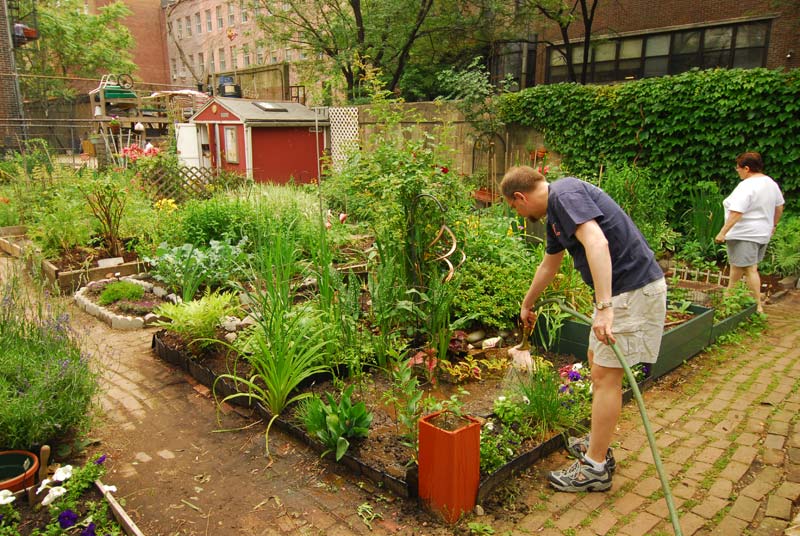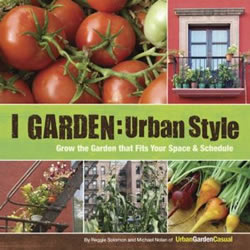Posted on 24 June 2010 by urbangardencasual.com
 By Mindy McIntosh-Shetter
By Mindy McIntosh-Shetter
As an avid gardener I cannot imagine not having some land, and when I say some land I am talking about 1/5 acre in my case.
My yard is divided up into space for my shed, 3 cars, landscaping in the front, my blueberry bed, Chestnut trees, and my herb and vegetable garden.
All my plants fit snugly on my land but what are people to do who want to garden but have no land.
Some container garden, some farm on walls, and some roof garden but I can tell you that nothing beats farming on the land.
As our population grows land becomes scarcer, the gardening movement grows and land is placed in a multi-use tug of war. From this agricultural paradox came the idea of yard-sharing. This concept was born from our two modern day obsessions, that is social networking and safe food with a little Freecycle and a dating website thrown in.
But how does this work? First, Read the rest of this entry »
Posted on 07 June 2010 by urbangardencasual.com
 By Mindy McIntosh-Shetter
By Mindy McIntosh-Shetter
Blueberries are great for urban gardens.
Their compact shape and texture can create visual interest in flowerbeds while being a perfect container plant if space or land is limited.
The trick to growing blueberries is one, keeping the soil acidic enough and two, planting at least 2 different varieties for fruit production.
To get started one must decide where you plant to plant your blueberries. This step is very important because the area or container will need to be supplemented with acid building materials 3 months before planting. The pH, lime index, nutrient status, and organic matter will Read the rest of this entry »
Posted on 03 June 2010 by urbangardencasual.com
 By By Mindy McIntosh-Shetter
By By Mindy McIntosh-Shetter
Thyme was an herb I discovered years ago when I was an Agriculture Instructor at a high school.
I had gone to a greenhouse in search of some unique plant material for container arrangements.
As I walked through the greenhouses I brushed up against a plant and found an olfactory heaven.
Thyme is one of those plants that the less your fuss with it the better it does. Also thyme likes dry soil and as a matter of fact wet or damp soils can cause root rot and create a perfect home for ants. Thyme also does well in cracks of rock walls or along stepping stones. It has also been used to create a “thyme lawn” whose aroma when stepped on fills the area with a Mediterranean breeze.
This plant is an aromatic shrub that grows 6-10” in height. The vegetation is gray-green to green that grows on woody stems that produce flowers that range from Read the rest of this entry »
Posted on 01 June 2010 by urbangardencasual.com
 By Sonya Welter
By Sonya Welter
Like all native wildflowers, the anise hyssop (Agastache foeniculum) provides food and habitat to wildlife.
But anise hyssop has another benefit: the leaves, flowers and seeds can all be used in the kitchen to make tea, sweets or marinades.
Anise hyssop is a perennial that grows about 24 to 36 inches tall and produces spiky purple flowers.
It’s native to most of Canada and northern parts of the United States, and in the wild it grows in upland forests, prairies and thickets. The flowers are a rich source of nectar, and bees love anise hyssop. Butterflies and hummingbirds will also nectar at the flowers.
True to its name, the leaves of anise hyssop have a scent reminiscent of licorice or anise, and the plant is also called “licorice mint.” The leaves can be used dried or fresh to make a spicy herbal tea.
Young leaves add a kick to mesclun salads. The flowers are slightly milder, but they add a bit of Read the rest of this entry »
Posted on 30 May 2010 by urbangardencasual.com
 By Sonya Welter
By Sonya Welter
I recently attended a workshop on permaculture gardening led by Dave Jacke, co-author of “Edible Forest Gardens.”
One of the tenants of permaculture is to share what you know with the community, so I thought I would take this opportunity to offer the readers of Urban Garden Casual a brief introduction to permaculture.
Permaculture is the ultimate in casual gardening, not because it is unplanned but because once it is established, a permaculture plot requires much less work than a conventional garden.
New beds are established with a no-dig technique known as sheet composting or lasagna gardening, and weeds are controlled with mulch instead of with hand pulling or herbicides. Plants are grown together in combinations that are mutually beneficial, so that you’ll have fewer pests, less disease and bigger yields.
With permaculture, what you are doing is creating Read the rest of this entry »
 By Mindy McIntosh-Shetter
By Mindy McIntosh-Shetter By Mindy McIntosh-Shetter
By Mindy McIntosh-Shetter By By Mindy McIntosh-Shetter
By By Mindy McIntosh-Shetter By Sonya Welter
By Sonya Welter By Sonya Welter
By Sonya Welter












